When you think of camping, hiking, backpacking, etc, do you have an image of a physically fit person in your mind? Someone with an athletic build who brings along only the healthiest energy bars and plenty of water?
You may be surprised to learn that, according to the 2021 North American Camping Report, more than 86 million households consider themselves to be campers.
Considering that more than two-thirds of Americans are overweight it’s safe to assume that plenty of those campers is overweight.
If you’re overweight and want to be able to go camping and still have fun then you’re in luck! There may be some additional challenges for someone who’s overweight, but that shouldn’t stop you from going out and enjoying the great outdoors.
What to prepare Camping While Fat
Tents
Carrying some extra pounds can make it hard to get comfortable when you’re camping. Finding the right tent is essential to ensuring you have a fun and relaxing experience. You’ll want to consider finding a tent that’s large enough for you to sleep comfortably and still offers adequate protection from the elements.
Large Tents
It can feel as though the world isn’t made for overweight people when it comes to camping equipment. Everything tends to be advertised as small and compact which may not be the most comfortable for someone with a bigger body type.
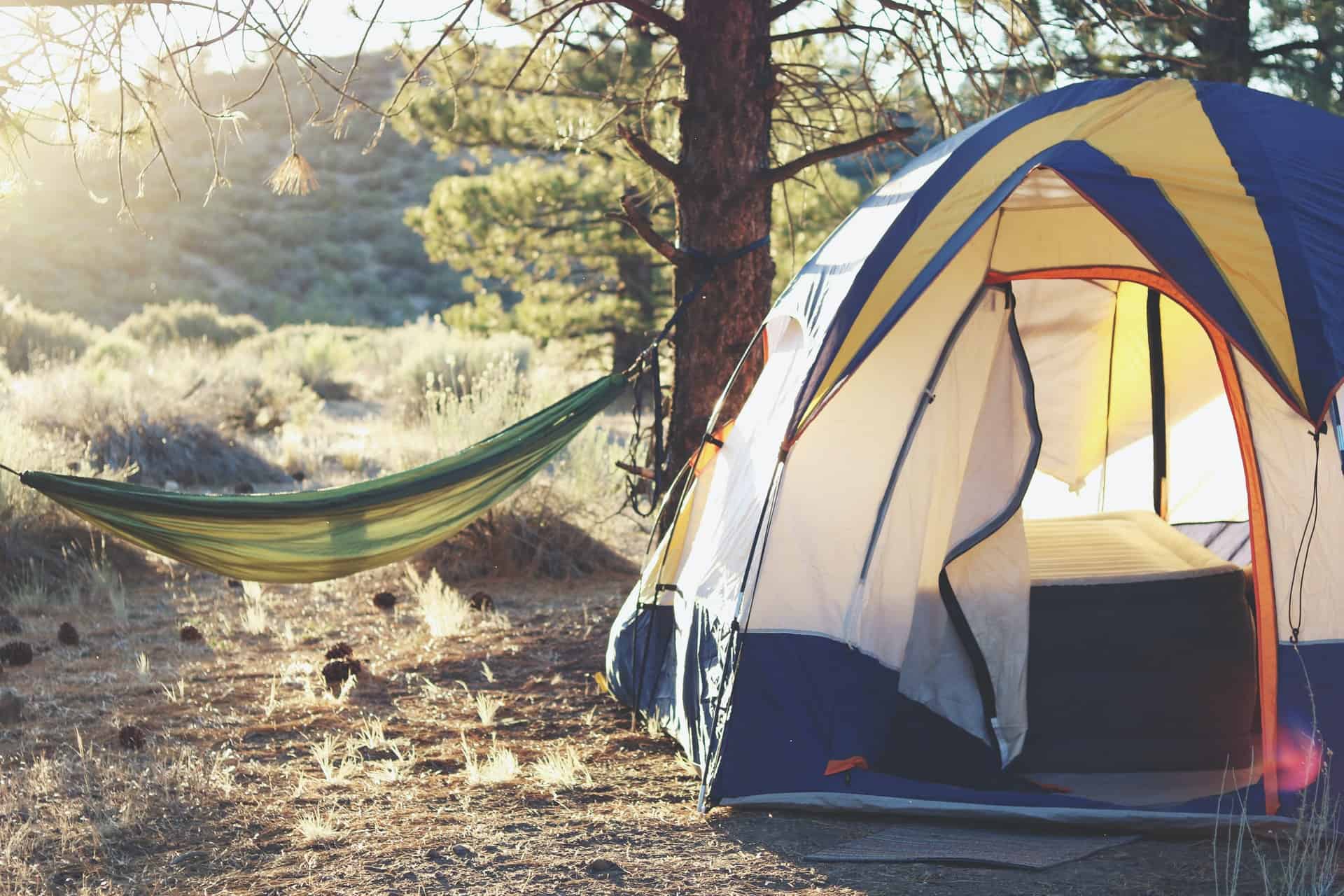
If you have trouble stopping and crawling then you’re going to need to buy a bigger tent for yourself. Most tents advertised in the 1-4 person range aren’t big enough for you to stand up in and this can be a problem for someone who’s overweight.
Most people that carry extra weight experience some back problems that can make crawling in and out of their tent a huge hassle.
The best solution is to buy a tent that you can actually stand up in. This will allow you to avoid irritating your back and give you plenty of room to maneuver around and get comfortable.
Dome-shaped tents are great for people who need a little extra room. They’re typically taller than other tents and some have extra features that make them appealing.
This Coleman Camping Tent would be perfect for a camper who’s carrying a little extra weight. It has 20% more headroom than other Coleman tents.
There’s also a wider door on this tent that’s great for giving yourself extra room and finagling your gear in and out of the tent.
Also Read: Hiking While Fat And Having Fun!
Sleeping Bag Vs. Cot
Rolling out a sleeping bag inside your tent while tending to a roaring fire as you settle in for the night is what most of us think of when we picture someone camping. It may surprise you to learn that there are options other than sleeping bags for overweight campers!
Sleeping bags are a tried and true method for camping. They’re what most of us picture other campers using and they’re what many seasoned campers recommend.
One of the main benefits of sleeping bags is that they require no effort to set up. You simply unroll it, unzip it, and slide in. This is incredibly convenient when you’re exhausted after a long day of hiking and a long night eating smores and telling stories around your campfire.
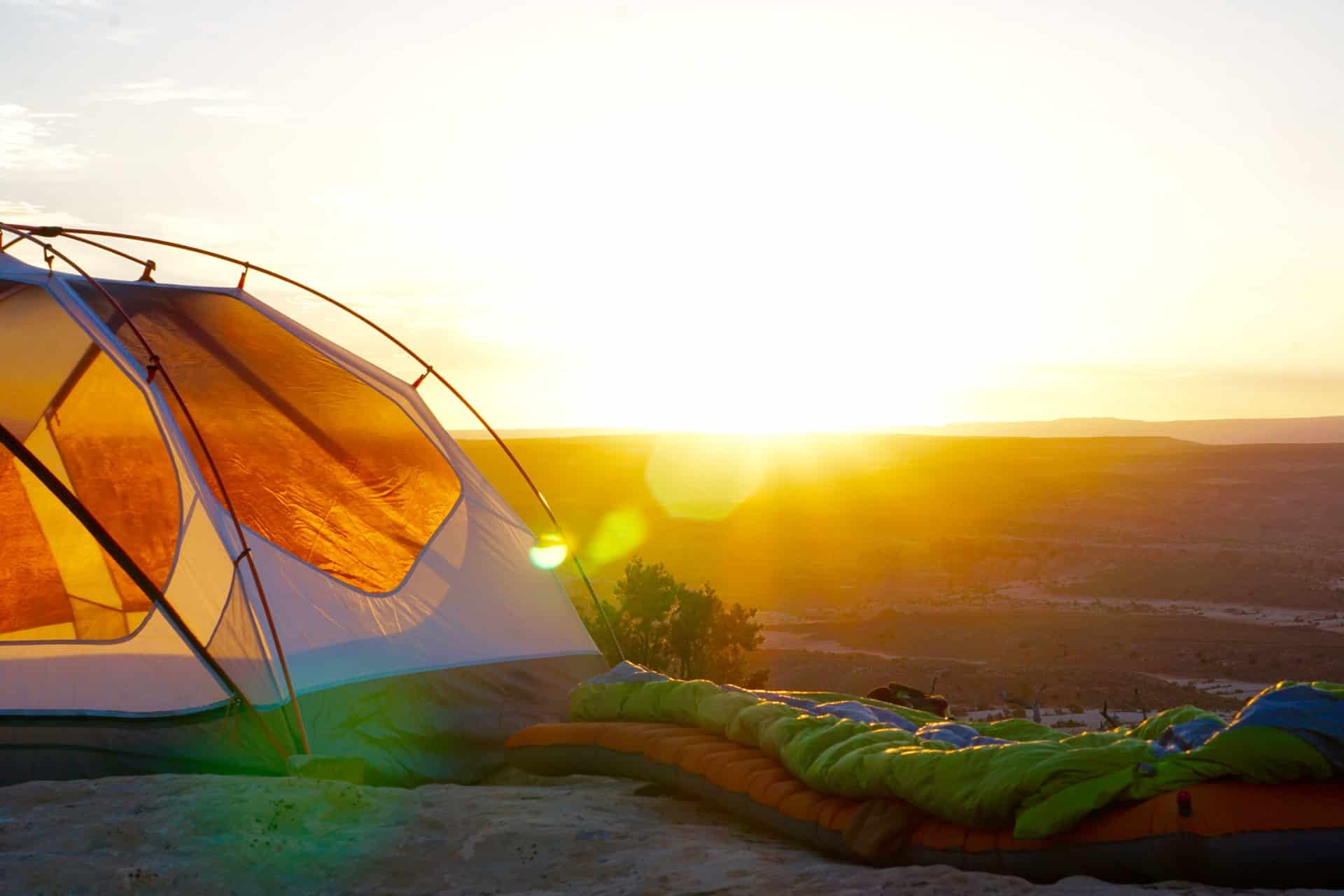
Sleeping bags also tend to be one of the warmest sleeping options. They’re essentially a little cozy cocoon. You won’t experience much of a draft with sleeping bags because of their cohesive design.
They also provide invaluable insulation from the ground. Laying on the ground can suck the heat out of your body quickly and sleeping bags are well-insulated to protect your body heat.
For a bigger person, a sleeping bag may not be the most comfortable option. They may not be thick enough to cushion your weight and laying on the ground can be quite uncomfortable for someone who’s overweight.
An excellent alternative is to bring along a cot. Camping cots tend to be more comfortable than sleeping bags for overweight campers.
They’re usually padded and some even come with a pillow, although you can always bring your own to use.
You can find camping cots rated for 500+lbs with a quick internet search. Cots get you up off the cold, hard ground which makes them a great option for keeping you warm and comfortable all night long.
One of the biggest benefits of using a cot in the storage room they create for you in your tent.
Once your cot is set up there is plenty of space to store the rest of your gear underneath it.
This gives you more room to move around in your tent and allows you to keep your gear close and organized.
The drawback to using a cot while camping is, of course, the weight. A cot that’s rated for a heavier person is going to be made with heavier material in order to support your weight.
This means that you’ll be carrying a 20+lb cot with you on your camping trip!
If you’re planning on going camping at a camp-site that you can drive up to then it would absolutely be worth it to bring along a cot.
However, if you’re going to be hiking for some time to get to your camping spot then you may want to consider going with a sleeping bag instead.
They’re a lot lighter than cots and take up much less space which gives you more room for your other gear.
Also Read: Cot vs Sleeping Pad
Staying Warm
Whether you’re camping in an area that experiences a large drop in temperature at night or you’re just sensitive to temperature changes you’re going to want to find ways to stay warm at night.
Sleeping Bag for a Heavy Person
As a bigger person, it can be a challenge to find a high-quality sleeping bag that will be comfortable and warm. Thankfully, many brands are now focusing on putting out products that meet everyone’s needs- including those of us who carry a little extra weight.
Coleman has a few sleeping bags that are great for overweight girls and guys. You’ll want to check the temperature rating on sleeping bags before you make your purchase to determine whether or not it’s suitable for the environment you’ll be camping in.
A great trick to finding sleeping bags made for bigger people is to search the phrase ‘big and tall’ when shopping around online. The number of options you have to choose from just may surprise you.
Read: Best Sleeping Pad For Side Sleepers
Layers
Layers are your best friend when you’re camping. Layers can help you stay warm and are perfect for an environment where the temperature fluctuates frequently.
Use thermal undergarments underneath your clothes if it’s going to be particularly cold. Then you can add a windbreaker, sweater, jacket, or any combination of those to help you stay warm.
If you’re camping somewhere particularly cold it may be beneficial to layer up on gloves and socks as well. Use a thin pair of gloves to start, then pull on thick gloves rated for the temperatures you’re going to be experiencing.

Wool socks are great for keeping your feet warm and dry. You may not think you need to worry about keeping your feet dry if you’re hiking in a warm and dry climate. But the simple act of hiking for an extended period of time will cause you to sweat and without the proper socks, you could be dealing with wet and cold feet.
Make sure you bring several extra pairs of socks unless you want to get stuck drying out your feet next to your campfire every night.
Sleeping Pads for a Heavy Person
One of the reasons campers tend to lose body heat at night is because they don’t have enough insulation between themselves and the ground.
A sleeping bag offers some insulation but not much. Sleeping pads are an excellent solution to this problem. You roll it out first and then put your sleeping bag on top of it. This creates another barrier between your body and the ground.
They’re ideal for overweight people because they provide extra insulation and cushioning. Using a sleeping pad is a great way to keep you warm and comfortable throughout the night.
They usually aren’t particularly heavy and don’t take up much more room than a sleeping bag. Sleeping pads tend to weigh 1.5lbs on average- that’s about one less pound than most sleeping bags weigh! They’re a great option that doesn’t force you to carry too much extra weight in your pack.
Pick a Good Campsite
We all know that heat rises, but how does that translate to your camping experience? It’s good to know that temperatures drop as you ascend in elevation. The higher up you are the colder you’re going to be.
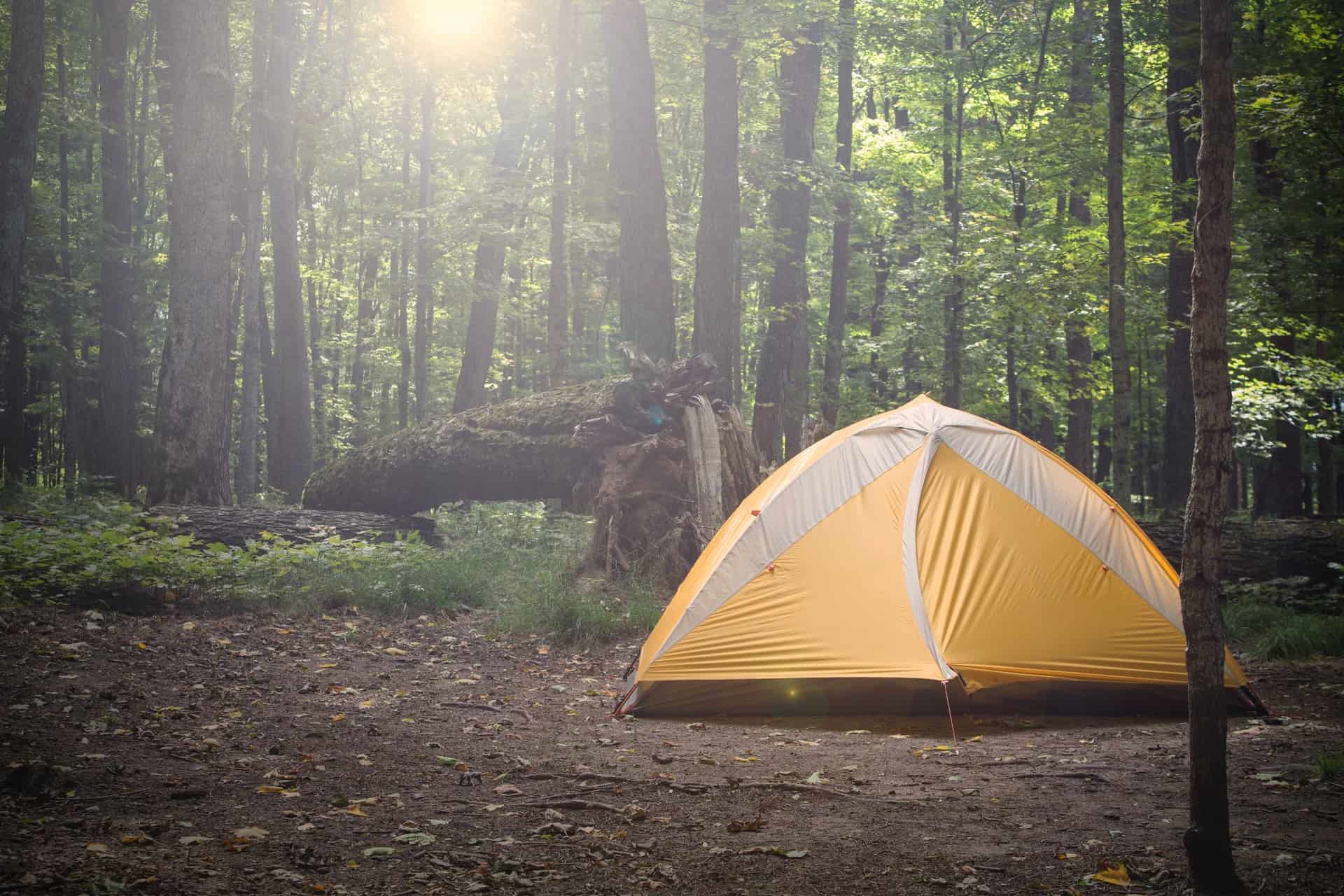
If you’re planning on hiking and camping in the mountains then you’re going to want to set up camp in a valley to avoid that high altitude cold. The same rule applies when hiking in an area with lots of lots. Always try to find a campsite that’s lower in elevation.
Another thing to keep in mind is camping near the water. Setting up camp next to a water source may be tempting but it’s not the best idea for staying warm.
In windy conditions spray from the water could make your campsite damp and cold. You’re also more likely to get caught up in fog which can make you and your supplies damp.
Avoiding sleeping too close to a body of water will help you stay warm at night. It’ll also keep you out of the path of bugs and animals who rely on that water source.
Warming Accessories
There are a few different accessories you can bring along to help keep you warm. They can be useful in addition to the rest of your gear.
Every camping store sells hand warmers. All you have to do is open the package, shake the warmers, and put them in your gloves or pockets.
They’re perfect for keeping your hands warm during your hike and throughout the night.
Most hand warmers advertise as being able to provide several hours of heat. These packs usually only weigh about 1lb which makes them a lightweight option to throw in your pack.
Another idea is a hot water bottle. Campers have been using these for ages and many people consider them a life-saver when temperatures have dropped unexpectedly during a camping trip.
Once your camp is set up for the night you want to heat some water to a boil. Pour the water carefully into your water bottle and then place it in your sleeping bag or cot.
You’re going to want a water bottle that’s uninsulated so it lets the heat out. Keeping this next to you will help keep you warm during unexpectedly chilly nights.
Camping Gear
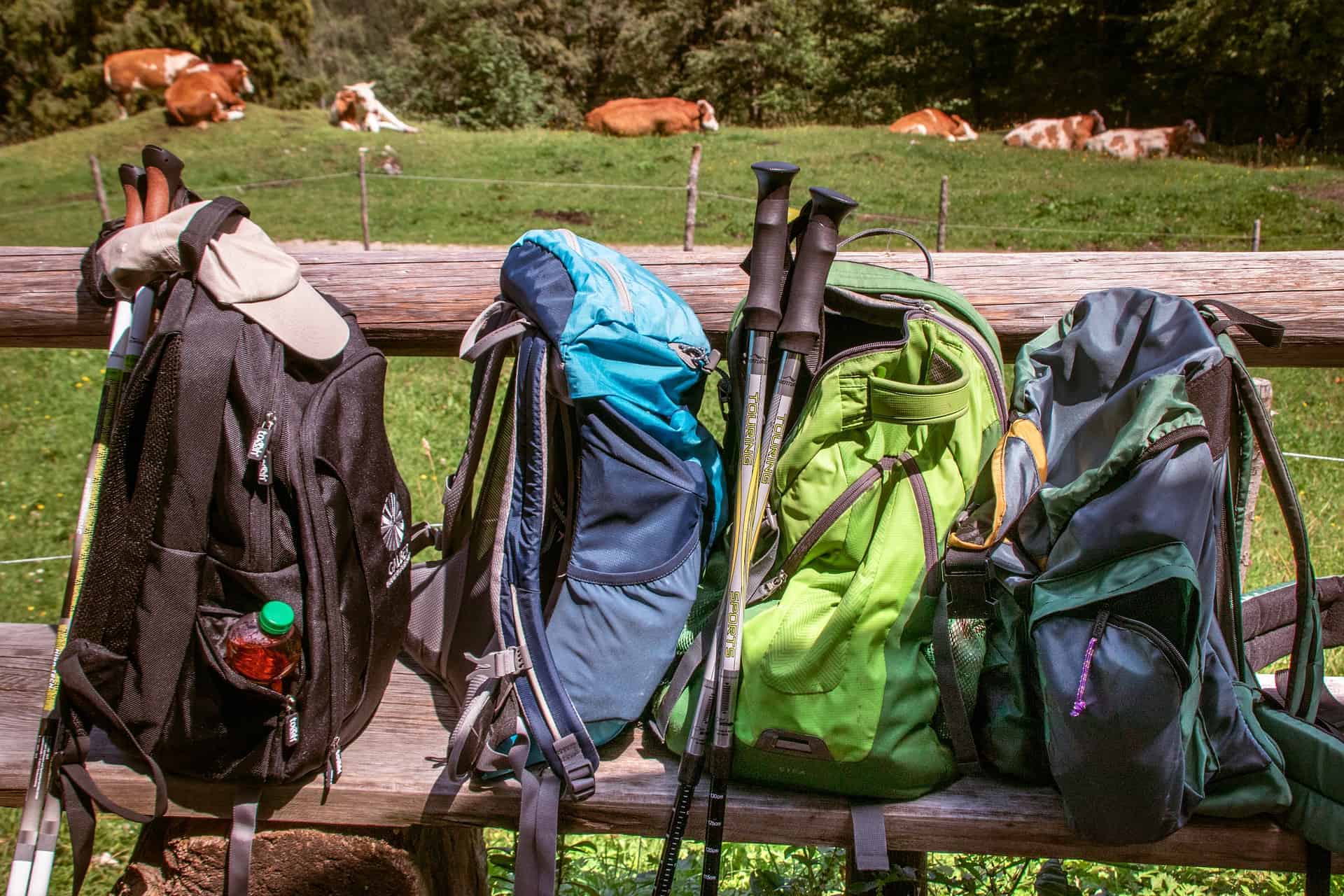
One of the most important decisions a camper must make before undertaking their outdoor adventure is what gear to bring. This is going to depend on a couple of factors.
- How many nights will you be camping?
- Will you be hiking?
- What will the weather be like?
- Are you bringing your pets?
Once you have a solid understanding of what you want your experience to look like you can begin preparing for it. The basic gear you’re going to want to bring with you includes:
- Food
- Water
- Tent
- Sleeping bag or cot
- Extra clothes and layers
- First Aid Kit
These are things that everyone needs to bring with them to have a positive camping experience. But what about other gears? Will you need trekking poles? What about deciding on the right foot wear? And are you sure you have the right gear for you to sit and relax around your campfire? Keep Reading to find out!
Trekking Poles
If you’re planning on doing some hiking then you may want to consider bringing along some trekking poles. Most people don’t consider them a necessity for hiking but they provide a lot of benefits, especially if you’re overweight.

Trekking poles are poles designed to help hikers with their stability and reduce stress on their joints.
This can be a game changer for overweight hikers who struggle with their balance. It can help you cover more ground more quickly by easing the strain on your body and helping you navigate tricky terrain.
Typically trekking poles are made out of either aluminum or carbon fiber. Aluminum based trekking poles tend to be a little heavier than their carbon fiber counterparts. However, they make up for that by being less expensive and less temperature-sensitive than carbon fiber poles.
They’re also easier to repair yourself. If you get a small bend in your aluminum pole while hiking over some rocky terrain it’s easy and quick to correct the bend so your trekking pole is back in working order.
Carbon fiber trekking poles are generally much lighter than aluminum based ones. This can make them the better option if you’re planning on hiking for a long period of time.
They’re also less flexible than aluminum poles which makes them less likely to bend when coming into contact with rocks, tree roots, and other obstacles you may come across.
Hiking Boots Vs Hiking Shoes
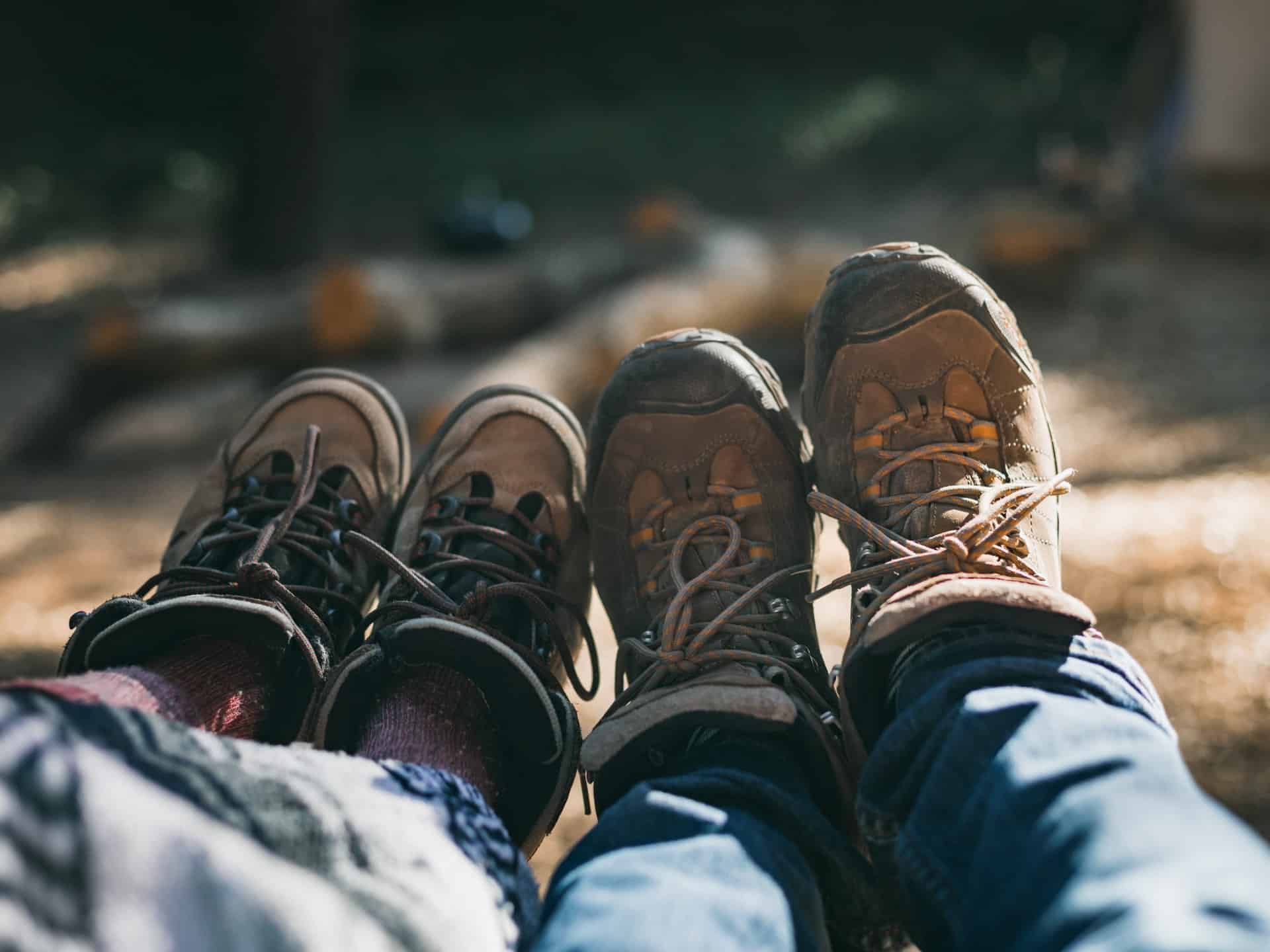
Your footwear is incredibly important to your hiking and camping experience. Studies show that it takes 4-6 times as much energy to carry weight on your feet than on your back. This is something you should keep in mind when choosing whether to wear hiking boots or shoes for your outdoor adventure.
Hiking boots
There are a lot of benefits to wearing hiking boots. They provide more support for your ankles which is important for people who are overweight or have had problems with their ankles in the past. Hiking boots are also made of a sturdier material. Boots are more likely to hold up in rough terrain.
You can find hiking boots that are water resistant as well. If you’re going to be hiking across streams or in a swampy area then these may be the best choice for you.
Hiking boots tend to have better traction than hiking shoes because of the hard-wearing rubber and multi-directional lugs that are built into the bottom of them. This can be particularly helpful for hiking over rocks and other slick surfaces.
All footwear should be comfortable- including your hiking boots. The thing to keep in mind with hiking boots is they generally take a little time to break in. So if you decide on boots for your hiking trips then you should consider wearing them around for a few days beforehand to get them properly broken in. The last thing you want in the middle of a 10 mile hike is blisters on your sore feet!
Hiking Shoes
There are many different types of hiking shoes. Some are designed as light-weight running shoes and others are designed with protective features similar to hiking boots.
Hiking shoes are lighter than boots which can save you some energy on long hikes. They’re also made with material that is more flexible and breathable than hiking boots. This would be good for someone who’s planning on covering a lot of ground quickly.
Some hiking shoes are rated for rough terrain but they’re best used for gentler trails. They’re generally a cheaper option than hiking boots so if money is a concern then you may want to look into a pair of good quality shoes.
sitting gear
There’s no better feeling than relaxing next to a warm fire after a long day of hiking and setting up your camp. There’s plenty of sitting gear for average weight folks, but what about those of us who are overweight?
Camping Chairs
Luckily there are plenty of options for campers who are on the heavier side. Classic folding camping chairs are an excellent choice for all campers. There are even several made especially for overweight people. Some chairs can handle up to 800lbs!
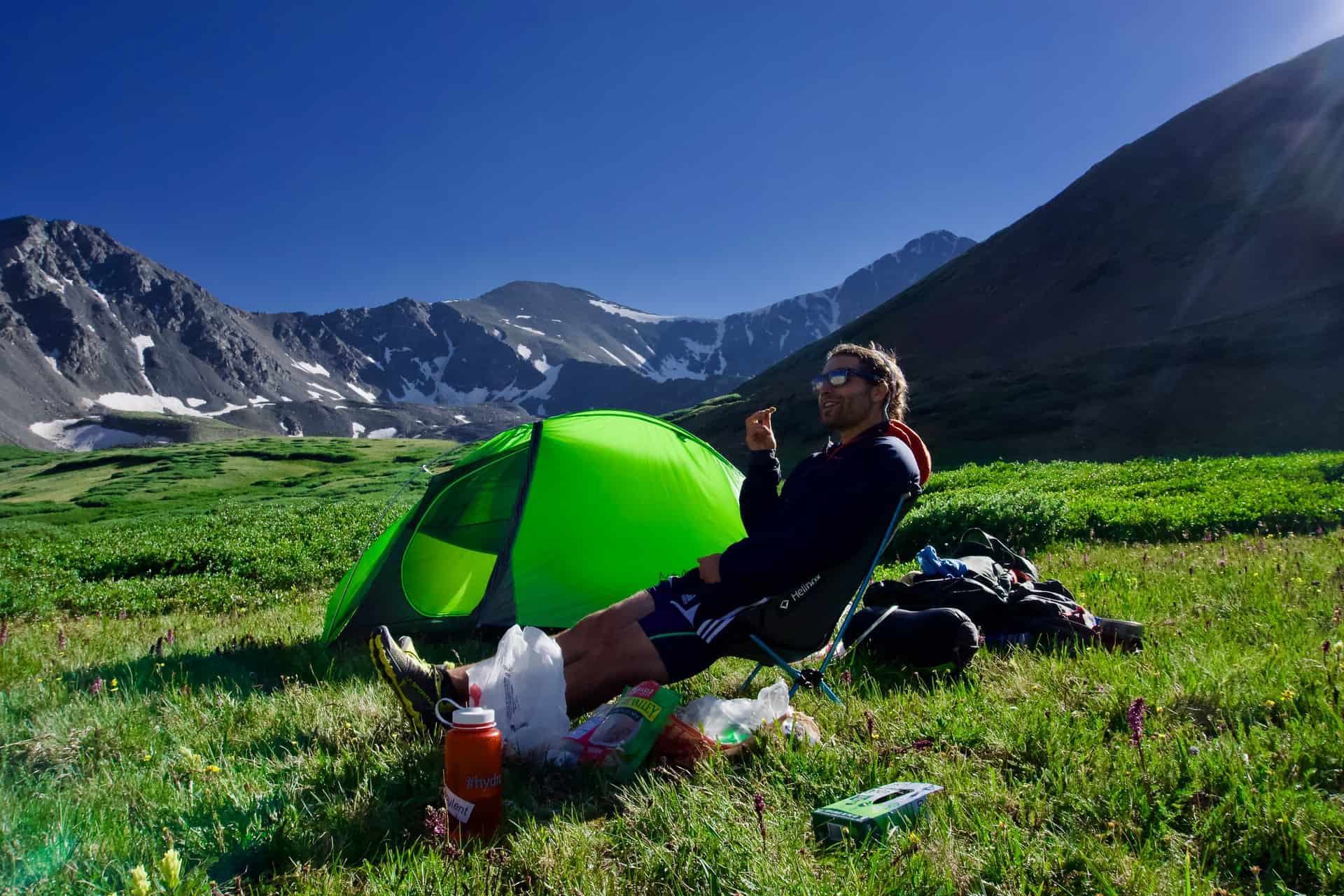
Camping chairs are super convenient because they’re designed to fold and unfold easily. That means very little effort to set them up and they’re generally made to be durable and long lasting.
The downside to bringing along camping chairs is their weight. These chairs tend to weigh between 8-13lbs when designed for a higher weight capacity.
This can be a little burdensome if you’re going to be hiking for an extended period of time with a lot of gear. For someone who’s overweight, carrying too much weight in their packs can increase their risk of injury and muscle strain.
Hammocks
Hammocks are incredibly comfortable and a very lightweight option to bring along. some hammocks are designed to hold up to 400lbs but if you need even more support than that then you’ll be pleasantly surprised to learn that some hammocks are rated to hold up to 800lbs!

Premium synthetic fabrics such as polyester and nylon are used to create hammocks that can support a high weight range. The hammock itself should only weigh between 4-10lbs depending on what brand you pick, what material it’s made out of, and if it has any extra features.
Some hammocks come with a canopy that sits above you and can shield you from rain or provide some shade in intense sunlight.
Others have extra material that you can pull over yourself. It’s usually referred to as a rainfly because the material is waterproof and designed to protect you in rainy or foggy weather.
Hammocks are a comfortable and lightweight option for overweight people. They do tend to be more expensive than camping chairs, however, and they’re not quite as easy to set up. A hammock needs to be tied off to two trees so that can make finding an ideal camping site more challenging as well.
Also Read: Best Camping Hammock For Side Sleepers
Nature
The best part about going camping and hiking is being surrounded by nature. If you’re on a tight budget or want to connect more with your surroundings then you can always rely on nature to provide what you need.

Set up camp in an area where there’s a stump or log you can use to sit on or up against. There’s almost zero possibility that these won’t be able to hold your weight. They may not be the most comfortable option but it’s certainly convenient.
Using what nature has to offer is something mankind has been doing since the beginning of our existence. Relying on nature will save you money, reduce the weight in your bag, and reduce the amount of time you spend setting up your camp.
Stay Safe
Hiking and camping can be a fun, revitalizing adventure that can provide amazing mental and physical health benefits. For you to get as much as you can out of this experience, it’s important to focus on safety.
Plan it out
Before you leave for your trip you should have a plan in place. You should know what date you’re going to leave, the date you plan to return, and the location of your camp or camps throughout the journey.
It can be helpful to get a map of the area you plan on camping at and mark exactly what trails you’ll be following. Mark where your campsites will be and give this map, along with any other relevant information, to a family member, spouse, or trusted friend.
Ask this person to contact the local authorities if you don’t return by the date you indicated.
It doesn’t take much to get lost in the wilderness. Going off the trail for a minute to check out a cool plant you’ve never seen before or to get a picture of a beautiful bird can completely disorient you.
Satellite Phone
One of the best parts about going camping is the ability to disconnect from the rest of the world. Going a week without having to check social media, respond to emails or texts, and separate from the daily grind is a big allure for outdoor enthusiasts.
It’s an amazing experience to just spend time with yourself.
So much of our lives are taken up by responding to others at work, home, and on social media that we often don’t make enough time for ourselves. Going out in nature helps us to listen to ourselves again.
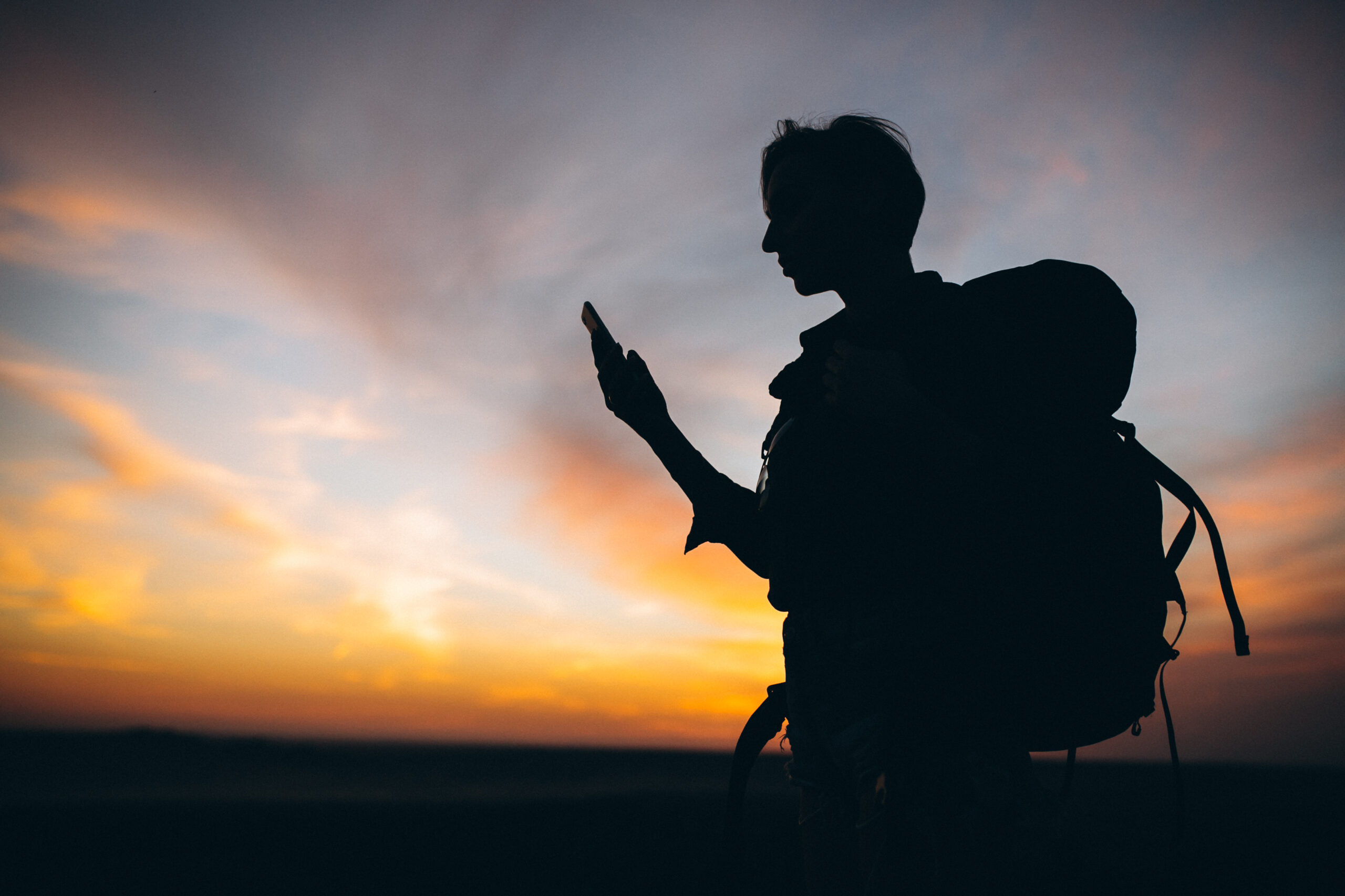
Bringing a satellite phone may seem like bringing a connection to the rest of the world that you don’t want, but it could save your life.
If you’re going camping or hiking somewhere off the grid then it’s almost a guarantee that your regular cell phone won’t have a signal.
If something goes wrong then you need a way to contact someone. Breaking an ankle 10 miles into your hike can be devastating if you’re by yourself with no way to reach out for help.
Satellite phones will allow you to make a call even when your regular cell phone doesn’t have a signal. You can also use it to call your family or friends should you decide to stay out longer than you originally planned.
These phones can be a little pricey but they will be well worth it. It’ll give you peace of mind in the event of an accident and it’ll give your loved ones back home peace of mind as well.
Also Read: How To Carry A Cell Phone While Hiking?
First-aid Kit
Bringing a first-aid kit along with is a no-brainer. It’s not uncommon for campers to get a little beat up along the way. In the event of a minor injury, you want to be prepared.
Leaving a wound untreated and uncovered in the wilderness increases your risk of infection dramatically and can turn your fun adventure into a nightmare.
There are plenty of first aid kits designed specifically for backpackers and campers that you can bring along with you. Making your own first aid kit is also a popular choice as you can individualize it to your situation and needs.
Some of the basic components of a first aid kit include:
- Antiseptic wipes
- Gauze pads
- Anti-itch ointment
- Burn ointment
- Antibacterial ointment
- Assorted adhesive bandages of various sizes
- Bandages
- Medical tape
- Safety pins
- Antihistamine to treat allergic reactions
- Fine-point tweezers
- Fever reducing medication
Most first aid kits will have the majority of all of these supplies. If you’re making your first aid kit then you want to be sure to include these basics. You’ll never know when you’ll need them and it’s better to be safe than sorry.
Whether you’re planning on making your first aid kit or just adding some extra supplies to one you bought it’s imperative to include supplies specific to your needs and situation.
Someone who’s overweight may experience some joint pain or swelling when camping.
To get the most out of your camping experience you should consider bringing along ibuprofen for the swelling and an over the counter pain reliever for any soreness. You may also want to bring along wraps or braces for your knees, ankles, and wrists.
Hiking puts a lot of strain on the body and you don’t want to have to cut your trip short because of sore ankles! Wrapping or bracing any sensitive areas will help keep them stable during your camping or hiking journey.
Another item you may want to consider bringing along is a pair of compression socks. This may seem like a strange item to bring along on your camping trip but if you’re overweight then they could be extremely beneficial for you.
Compression socks are designed to gently squeeze your feet to stimulate blood flow. This will help reduce swelling and can help to prevent blood clots.
If you’re overweight and not used to exercise then a long hike to your camping spot could cause painful swelling.
Throwing on a pair of compression socks once you’ve finished setting up camp will help you relax and unwind after a long day of hiking.
Depending on the weather where you’ll be hiking you may want to include sunscreen.
It’s also a good idea to bring along throat lozenges, eye drops, antacid tablets, and any prescription medications you may be taking.
It never hurts to be prepared for accidents and injuries when you go camping. Having the proper supplies will keep your trip from being derailed by any accidents.
Final Thoughts
There’s absolutely no reason why being overweight should prevent you from enjoying your camping trip! These suggestions will help you to get the most out of your adventure and minimize any difficulties you may run into. Get your gear together and get camping because it’s an activity that everyone can enjoy.
For more related guides read my other posts:
- How To Keep A Tent Cool In The Summer?
- Best Hiking Leggings With Pockets
- Battery Powered Heater For Camping
- Best Power Inverters for Camping
- Best Long Sleeve Hiking Shirts For Hot Weather
- Best Leggings For Winter Hiking
Thanks for reading and happy camping!
About the Author

Hussain is a passionate hiker and traveler that love the outdoor and enjoys what nature has to give, whenever he can he love to write and give tips & honest reviews to help others get out there and just seek more unforgettable experiences.

